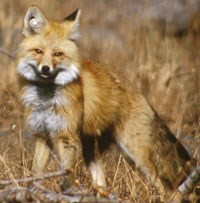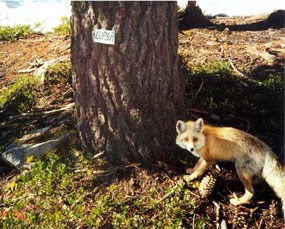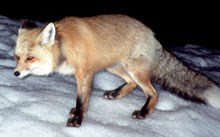|
Yosemite National Park’s wildlife biologists monitor all the park's mammals but focus heavily on animals listed as endangered or threatened in order to ensure their long-term survival. Of Yosemite’s special status mammal species, the Sierra Nevada bighorn sheep, the California wolverine, and the Pacific fisher are listed under the U.S. Endangered Species Act, and the Sierra Nevada red fox and the California wolverine are part of the 14 mammals protected by the state of California. 
Keith Slausen, USFS / PSW Sierra Nevada Red Fox: State Threatened
Slightly smaller and darker than the introduced lowland population of red foxes, the Sierra Nevada red fox (Vulpes vulpes necator) is one of two native species of fox in Yosemite. Due to rare sightings, relatively little is known of the life history of the Sierra Nevada red fox, but it is assumed that its habits are similar to those of other red foxes regarding den choice, hunting tactics, and breeding behavior. Photographs of the Sierra Nevada red fox were taken at Lassen National Forest during a 1990 study of another animal, the wolverine, when remotely triggered cameras captured a Sierra Nevada red fox on film. To attempt to document the elusive red fox in Yosemite in fall 2010, the park's wildlife biologists have placed three cameras in the Tioga Pass area where the last documented sighting occurred in the early 1990s. The cameras, which will remain posted until mid-November, cover a four-square-mile grid for potential red fox activity. Yosemite's mammal-sighting momentum builds on an August 2010 sighting near Sonora Pass, north of the park in the Sierra Nevada. There, a remotely triggered trail camera photographed a Sierra Nevada red fox biting a bait bag of chicken scraps. That bait bag was sent to geneticists at UC Davis to analyze saliva samples, and DNA results confirmed it as a Sierra Nevada red fox. 
John Perrine, Cal Poly State University The fox's range is from the Cascade Range east to the Sierra Nevada and then south along the Sierran Crest to Tulare County. Sightings of the subspecies range from 5,000 to 7,000 feet in elevation with extremes placed at 3,900 feet in Yosemite Valley and 11,900 feet at Lake South America in the southern Sierra Nevada. You would be most likely in summer to see a Sierra Nevada red fox above 6,000 feet in the subalpine zone, amongst the red fir and lodgepole pines, and alpine fell-fields. These fox, however, inhabit remote areas of the state where chance encounters with humans are uncommon. Some scientists have come to the conclusion that Sierra Nevada red fox likely never occurred in large numbers, relying on references in Joseph Grinnell's Fur-bearing Mammals of California, written in 1937. During the 1940s and 1950s, trappers collected 135 pelts and that number shrunk to just two pelts a year by the 1970s. The state of California banned Sierra Nevada red fox trapping in 1974 and added the animal to the state-threatened list in 1980, where it remains today. The numbers of native fox decline while non-native red fox populations increase and compete for food, particularly in the Central Valley. Research in the late 1990s by UC Berkeley biologist Tom Kucera followed by colleague John Dixon Perrine highlighted the only known population, located in Lassen National Forest. In late 1997, a young male fox begging at a campground was captured and radio-collared, and, in early 1998, a female fox was likewise captured and collared in Lassen. These were the first individuals of this species ever captured and radio-collared in California. Eventually, with the help of remotely triggered cameras, a population of 10 to 15 individuals was documented in the Lassen Peak vicinity, located in Lassen Volcanic National Park. 
John Perrine / Cal Poly Read a 2010 state of the red fox in the U.S. Forest Service’s Sierra Nevada Red Fox (Vulpes vulpes necator): A Conservation Assessment, by John Perrine, Lori Campbell and Gregory Green. In an attempt to save this important mammal, other Sierra Nevada-related studies are taking place. The California Department of Fish and Game is currently surveying high-elevation habitats in the southern Cascade and Sierra Nevada ranges, both north and south of Yosemite, for the Sierra Nevada red fox and other mesocarnivores. Using baited camera stations and passive hair-snaring devices, the 2009-2011 project aims to expand knowledge of the distribution of the fox and to investigate the genetic characteristics of its populations.
Wolverine: State Threatened
An enigmatic and elusive carnivore recently showed up in Yosemite! On May 24, 2023, a park ranger in Yosemite National Park was fortunate to catch sight of a wolverine (Gulo gulo) in the backcountry of Yosemite National Park. The wolverine is the latest in a string of chance observations in the Sierra Nevada mountains, and researchers believe these recent sightings may be the same individual. Amazingly, this rare glimpse of a wolverine is only the second confirmed detection of this species in California in more than one hundred years! Formerly a California native, the wolverine is thought to have become locally extinct after the last specimen was collected in 1922. While there have been a handful of unvalidated reports of wolverines in California after this date, it wasn’t until 2008 that a wolverine definitively turned up on a camera station just north of the Lake Tahoe area. Subsequent collection of the 2008 individual’s DNA-laden scat revealed a genetic signature that closely matched the Rocky Mountain population. This event supports the concept that gene flow between the Sierra Nevada and the Rocky Mountains could be bridged as these adventurous travelers move long distances during large snow years. These wild carnivores are sometimes described as phantoms due to their elusive behavior and mysterious traits. Belonging to the weasel family, wolverines are closely related to martens and fishers in North America, and to their Central and South American counterpart, the tayra. Wolverines have an incredible sense of smell and can detect carcasses twenty feet under the snow. As opportunistic feeders, they tend to scavenge dead animals killed by other predators such as wolves or bears. After they cache their food, they will mark the spot by lifting their tail and emitting an offensive odor (hence the alternate common name: “skunk bear”). However, wolverines are also excellent hunters, capable of bringing down large prey in deep snow and excavating ground squirrels and other small mammals with their exceptionally long claws. Currently, much is unknown about this new visitor to the Sierra Nevada Mountains. Efforts are underway to collect biological samples from this individual to address pertinent questions, such as the animal’s sex and origin. Most likely this wolverine is a dispersing male. Occasionally, young males get wanderlust and will explore new areas, sometimes traveling hundreds of miles from their native range. But without a female companion to start a small population in a new area, genetic diversity will remain low unless more wolverines establish territories and inhabit this mountain range. Despite these challenges, just a glimpse of this lone traveler is exciting, as any evidence, such as tracks, is widely sought after but seldom found. The record snowpack in the region this past winter may have allowed this wolverine to move farther south than otherwise possible. “Seeing the wolverine reminded me that Yosemite is a wild place and how many other incredible, wild and capable beings we share this place with,” Tim Knaus reflected on his lucky experience. Whether this animal stays in the Sierra Nevada or roams back north and east, it’s an encouraging sight to see the intrepid wolverine return to its home in the Sierra Nevada. |
Last updated: September 22, 2025
